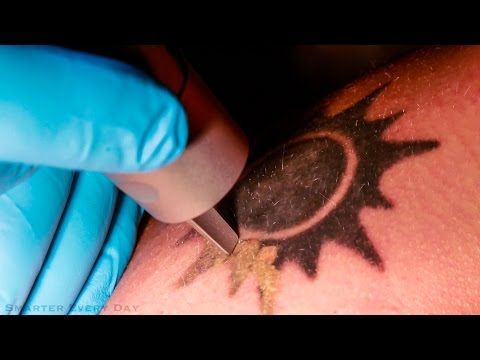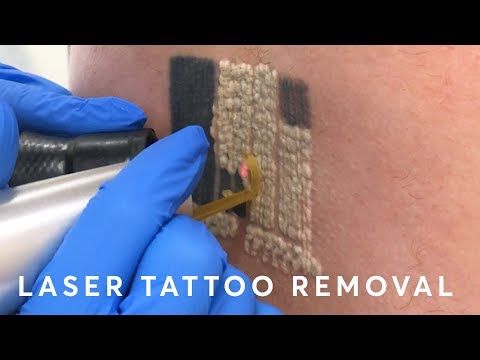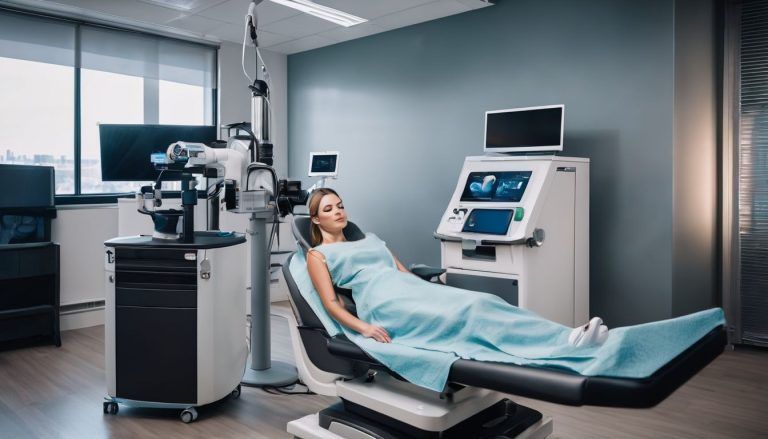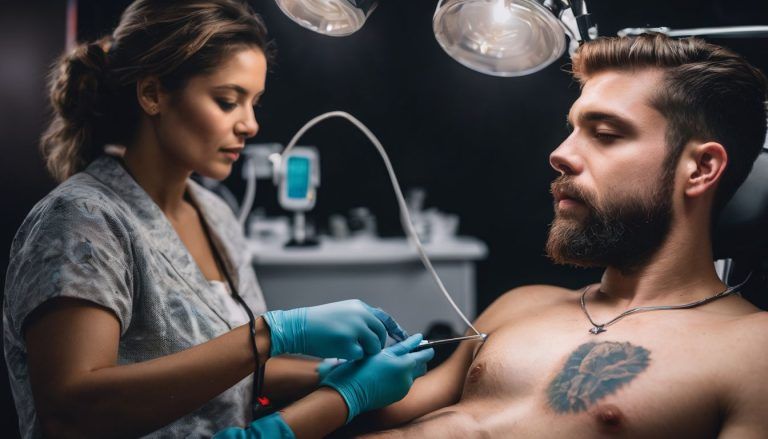The Ultimate Guide to Tattoo Removal: Methods, Risks, and Results
Tattoos can be bold statements, but sometimes we change our minds. Did you know that laser tattoo removal is the most popular way to erase past ink? Our guide will show you safe methods and what results to expect when removing a tattoo.
Keep reading for the ultimate tattoo undo!
Key Takeaways
- The most popular method for tattoo removal is laser surgery, known for targeting various types of tattoos without causing significant damage to surrounding skin.
- Different factors, such as skin type, tattoo colors, and age of the tattoo, can significantly impact the success of tattoo removal and must be considered before undergoing any procedure.
- Common risks associated with tattoo removal include temporary side effects like redness and swelling, along with the possibility of scarring. It’s crucial to consult with a reputable doctor specializing in tattoo removal to understand potential outcomes based on individual circumstances.
Understanding Tattoo Removal
Understanding tattoo removal involves knowing the reasons for removal, the types of tattoos that can be removed, and the factors that affect removal success. This section will delve into these key aspects to provide a comprehensive understanding of tattoo removal.
Reasons for removal
People decide to remove tattoos for various personal reasons. A common one is tattoo regret, where the design no longer represents a person’s current beliefs or lifestyle. Sometimes professional circumstances demand removal, as visible tattoos may not align with certain job requirements.
Changes in skin over time can also lead to distorted tattoos that people want to erase.
Another motivator can be emotional healing; for instance, removing tattoos related to past relationships or experiences can provide a sense of closure. Health-related concerns may arise too—some individuals experience allergic reactions to the tattoo ink and need it removed for their wellbeing.
Advances in technology like PicoSure laser tattoo removal have made erasing unwanted ink more accessible, offering a chance for people to start afresh without permanent reminders of the past on their skin.
Types of tattoos that can be removed
When considering tattoo removal, it’s important to understand the types of tattoos that can be effectively removed. While all types of tattoos can be targeted for removal, those with black ink are generally the most responsive to treatment.
However, colored tattoos may require specialized laser wavelengths for effective removal. Additionally, older tattoos tend to fade more easily compared to newer ones due to natural degradation of ink over time.
It’s essential to consult a qualified professional who can assess the tattoo and recommend the most suitable removal method based on its size, color complexity, and placement.
Factors that affect removal success
Various factors can significantly impact the success of tattoo removal. These include:
- Skin type: Different skin types may respond differently to removal methods, affecting the effectiveness of the process.
- Tattoo colors: Some ink colors are more difficult to remove than others, with darker colors typically requiring more treatments.
- Age of the tattoo: Older tattoos may fade more readily than newer ones due to the breakdown of ink over time.
- Tattoo location: Tattoos located closer to the heart tend to fade faster due to increased blood flow, while those on extremities may require more treatments.
- Health and lifestyle: Overall health, smoking, and sun exposure can affect how well the body responds to removal treatments.
Methods of Tattoo Removal
Laser surgery, surgical removal, dermabrasion, and chemical peels are some of the methods used for tattoo removal. Each method has its own benefits and risks, so it’s important to consider all options before making a decision.
Laser surgery
Laser surgery is a popular method for removing tattoos, utilizing laser energy to break down tattoo ink particles. This process targets the pigment in the skin without causing significant damage to surrounding tissue.
Laser treatment is considered one of the safer options, with lower risks of scarring compared to surgical excision or chemical peels. It may cause temporary side effects such as redness, swelling, and blistering, but these generally subside with proper aftercare.
When considering tattoo removal options, it’s crucial to understand the specific risks and benefits associated with each method. Moving forward, let’s delve into another widely used approach – Surgical Removal.
Surgical removal
Transitioning from laser surgery to surgical removal, another method for removing tattoos is through surgical excision. This technique involves cutting out the tattooed skin and stitching the surrounding skin back together.
Generally best suited for small tattoos, this method effectively removes the entire tattoo in one session. However, it may result in more visible scarring compared to other methods and requires a longer healing period.
Surgical removal poses risks such as infection and potential changes in skin texture or color at the excision site.
While surgical removal can yield immediate results, it’s essential to consider potential scarring and longer recovery time before opting for this method. Factors like tattoo size, location on the body, and skin type play crucial roles in determining whether surgical removal is a suitable choice.
Dermabrasion
Dermabrasion involves removing the top layers of skin using a rapidly rotating brush or wheel. This method is effective for lightening or completely removing tattoos, particularly older and faded ones.
Dermabrasion’s aggressive nature means it can cause scarring and changes in skin texture, making it less popular than laser surgery for tattoo removal.
While dermabrasion poses risks such as scarring and changes in skin texture, it may be suitable for individuals with specific tattoo types or those seeking an alternative to laser surgery.
Chemical peels
Transitioning from dermabrasion to chemical peels, another method for tattoo removal involves the use of chemical peels. Unlike dermabrasion that physically removes the top layer of skin, chemical peels work by applying a solution to peel away the upper layers of the skin where the tattoo ink is located.
This causes new skin cells to grow in place of those removed during the procedure.
Chemical peels offer a less invasive option for tattoo removal and are best suited for smaller tattoos or as part of a multi-faceted approach when combined with other methods. However, there is a risk of scarring and changes in skin pigmentation associated with this method, making it crucial to consult with a medical professional before considering chemical peels for tattoo removal.
Risks of Tattoo Removal
Pain and potential side effects are common risks associated with tattoo removal procedures, as well as the possibility of scarring. It’s important to understand these risks before undergoing any type of tattoo removal method.
Pain and side effects
Tattoo removal can cause temporary side effects, including redness, swelling, blistering, and scarring. Laser treatment is generally safer than other methods such as excision or dermabrasion, but it can still carry risks of infection and skin discoloration.
While laser tattoo removal may be painful for some individuals during the procedure, it is important to note that pain levels vary from person to person. It is crucial to consult with a reputable doctor specializing in tattoo removal to understand the potential side effects and determine which method suits your skin type and desired results.
Scarring is a common risk associated with most tattoo removal methods. In addition to the possibility of scarring, there is also a risk of infection or skin discoloration following the procedure.
Scarring
Scarring is a common concern after tattoo removal, especially with methods like dermabrasion and chemical peels. Laser tattoo removal and certain creams are less likely to cause scarring due to their precision in targeting ink particles without damaging the surrounding skin.
However, it’s important to note that any method of tattoo removal carries some risk of scarring, as the body’s healing process can vary from person to person.
The possibility of scarring underscores the importance of consulting with a reputable doctor before undergoing any tattoo removal procedure. Factors such as skin type and existing medical conditions can influence the likelihood of scarring.
What to Expect During and After Tattoo Removal
Before undergoing tattoo removal, it’s important to prepare for the procedure and understand what to expect during and after the process. From the details of the actual removal to recovery and aftercare, there are key factors that can impact your experience with tattoo removal.
Preparation
Preparation for tattoo removal involves several important steps to ensure the process goes smoothly and leads to successful results. Here are the essential aspects of preparation:
- Consultation with a reputable doctor who specializes in tattoo removal is crucial
- Discuss potential risks, side effects, and expected outcomes with the doctor
- Provide your medical history and any existing conditions to assess suitability for tattoo removal
- Follow any pre – treatment instructions provided by the doctor or clinic
- Avoid sun exposure on the tattooed area before the removal procedure
- Consider arranging for transportation home after the treatment, especially if undergoing laser tattoo removal
- Plan for necessary time off work or daily activities to allow for proper recovery post – treatment
Procedure details
After adequately preparing for tattoo removal, the procedure entails detailed steps for optimal results:
- The skin is thoroughly cleaned and sterilized before the removal process, ensuring a safe and hygienic environment.
- The doctor marks the boundaries of the tattoo to precisely target the area during the procedure.
- During laser tattoo removal, the specialist uses a handheld device to deliver focused beams of light onto the skin, breaking down the ink particles.
- Surgical removal involves cutting out the tattooed skin and stitching the remaining edges of skin together for healing.
- Dermabrasion includes using a high – speed rotary device to sand away layers of skin, effectively removing tattoos.
- Chemical peels utilize acid solutions to remove layers of skin gradually, ultimately fading the tattoo over time.
Recovery and aftercare
After undergoing the tattoo removal procedure, proper recovery and aftercare are crucial for optimal results and minimal side effects. Here are essential tips to ensure a smooth healing process:
- Keep the treated area clean and dry to prevent infection.
- Apply any prescribed ointments or creams as directed by your doctor to aid in the healing process.
- Avoid exposure to direct sunlight on the treated area to prevent skin damage and complications.
- Refrain from picking at scabs or peeling skin to prevent scarring and promote proper healing.
- Follow any specific aftercare instructions provided by your doctor, such as avoiding certain activities or wearing bandages.
Conclusion and Tips
When considering tattoo removal, it’s important to find a reputable doctor and carefully weigh the pros and cons of each method. FAQs and top picks for tattoo removal methods can provide additional guidance for those seeking to erase their ink.
Importance of finding a reputable doctor
When seeking tattoo removal, it is critical to find a reputable doctor with extensive experience in the field. A skilled and qualified professional can assess your skin type, medical history, and tattoo specifics to recommend the most suitable removal method for optimal results.
Additionally, a reputable doctor will prioritize safety protocols during the procedure, minimizing potential risks of scarring and other complications. By choosing an experienced practitioner, you can increase the likelihood of successful tattoo removal while minimizing adverse effects.
FAQs
- Importance of finding a reputable doctor is crucial when considering tattoo removal. Now, let’s address some common questions that individuals have about the tattoo removal process and its associated risks.
- “What are the most common side effects of tattoo removal, and how can they be managed?”
Common side effects include temporary redness, swelling, blistering, and scarring. These can be managed through proper aftercare routines recommended by the doctor.
- “Is laser tattoo removal painful, and how can one manage the discomfort during the procedure?”
- “How long does it take for a tattoo to fade or be completely removed with laser treatment?”
- “Are there any home remedies or over-the-counter creams that effectively remove tattoos?”
- “Are there specific factors that make an individual unsuitable for certain types of tattoo removal methods?”
- “What is the average cost of laser tattoo removal per session and what affects this cost?”
- “Is it possible to completely avoid scarring after a successful tattoo removal procedure?”
Top picks for tattoo removal methods
- FAQs about tattoo removal methods are common, and here are the top picks for safe and effective tattoo removal:
- Laser Tattoo Removal: Utilizing laser technology to break down ink particles, this method is generally safer and less likely to cause scarring compared to other techniques.
- Tattoo Removal Creams: These creams work by gradually fading the tattoo over time, with minimal risk of scarring or skin discoloration.
- Surgical Excision: Involves cutting out the tattooed skin and stitching the surrounding skin back together, often used for small tattoos with minimal scarring risk.
- Dermabrasion: This method involves sanding down the skin to remove the tattoo ink, but it carries a higher risk of scarring compared to laser treatment.
- Chemical Peels: Uses acid solutions to exfoliate layers of skin, potentially removing the tattoo ink but carrying a higher risk of side effects such as scarring.
- Salabrasion: A technique that involves rubbing coarse salt against the skin to remove layers and gradually fade the tattoo; however, it poses a risk of infection and scarring.
- PicoSure Laser Treatment: This advanced laser technology delivers ultra-short pulses of energy to target tattoo ink while minimizing damage to surrounding skin cells.
These top picks offer various options for safe and effective tattoo removal depending on factors such as desired results, pain tolerance, budget, and existing medical conditions.
FAQs
1. What methods are used for tattoo removal?
Tattoo removal techniques include laser treatments, surgical excision, and other procedures that aim to fade or completely remove tattoos from your skin.
2. Are there risks to removing a tattoo?
Yes, there are tattoo removal risks such as scarring, infection, and changes in skin texture which can occur during the healing process after the procedure.
3. What should you do for tattoo removal aftercare?
To care for your skin following a tattoo removal surgery or treatment, follow your doctor’s advice closely—this typically includes keeping the area clean and protected from sunlight to promote proper healing.
4. How much does it usually cost to get a tattoo removed?
The cost of tattoo removal can vary widely based on several factors like the size of the tattoo, its location on your body, and how many sessions you need to fully remove or cover up an unwanted tattoo.







